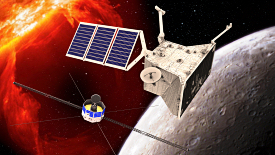BepiColombo launch moved to 2017
30 March 2015
The launch of BepiColombo, an ESA mission to explore the planet Mercury in collaboration with the Japanese space agency, JAXA, is now planned to take place during a one month long window starting on 27 January 2017.
 |
|
Artist's impression of BepiColombo. Credit: ESA |
BepiColombo is an ambitious mission comprising two separate orbiters, the ESA-led Mercury Planetary Orbiter (MPO) and the JAXA-led Mercury Magnetospheric Orbiter (MMO), as well as a carrier spacecraft, known as the Mercury Transfer Module (MTM).
In recent months, all three spacecraft have passed important milestones, with the successful completion of MPO thermal vacuum tests at ESA's European Space Research and Technology Centre (ESTEC) in the Netherlands, and MMO environmental tests, in Japan, at the end of 2014. In February, the first mating of the MTM and MPO flight modules at ESTEC took place smoothly. These two spacecraft will soon be joined by the MMO, which is due to arrive at ESTEC next month.
During this period, a major review of BepiColombo – the Mission Critical Design Review – took place. This review, which examined all aspects of the design of the mission, was successfully completed on 25 March.
One aspect of the mission that was examined during the review period was the launch of BepiColombo, which had been targeted for a window opening in July 2016. However, as the result of delays in the procurement of critical units and the availability of some payloads, a decision was taken to opt for a later launch opportunity in order to minimise the operational risk to this ambitious dual mission.
The pre-launch test campaign for the spacecraft is now expected to be completed in December 2016, leading to a window for launch on an Ariane 5 from ESA's spaceport at Kourou, starting on 27 January 2017. Nevertheless, BepiColombo will still arrive at Mercury at the same time (January 2024) as if launched in mid-2016.
The spacecraft will reach Mercury using a highly efficient, low thrust, electric propulsion system that will steadily propel it along a series of arcs around the Sun. The trajectory will also be modified by eight planetary flybys.
BepiColombo will return to Earth's vicinity in July 2018, encounter Venus in 2019 and 2020, and then receive five gravity assists from Mercury itself between 2020 and 2023.
Once the spacecraft's speed has been slowed sufficiently by these manoeuvres, the MTM will be jettisoned and BepiColombo will be captured by Mercury's gravity in January 2024. The MPO will then fire its chemical propulsion thrusters to lower the orbit before the European and Japanese craft separate and begin their different missions.
Once the orbiters are deployed in their separate orbits around the innermost planet, they will carry out the most comprehensive exploration of Mercury and its environment ever undertaken.
The two orbiters will explore Mercury for one Earth year (4 Mercury years), with the option of a one-year extension.
